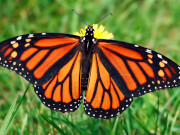15 Steps - Helping the Planet with Your Plants

Like people, plants need care and attention. Here in Southern California, our plants will not do well if they are not watered, especially in the hot weather we are enduring in August.
Having a garden is more than planting various types of plants and watering them from time to time.
Trees
Trees are one of the most important species on this planet. They function as the Earth’s lungs. They take in carbon dioxide and emit oxygen.
With cities expanding and rainforests being cutback, we all need to plant trees. Please plant trees that are native to your locale. Planting a thirsty tree in an arid area is a bad idea.
Most people will recognize that planting a tree that needs a lot of water in an arid area is a bad idea and may kill the tree if it does not get enough water. Conversely, planting a tree that is native to arid areas is not good for that tree.
Nonnative Plants
Nonnative plants are not good for many areas because they may grow differently in the new area than in their native location. The difference could be choking out native species. Also, many nonnative species may need more water than locally native plants.
Nonnative plants may harbor insects and other pests that might run rampant in the new surroundings. Their natural enemies are no longer at hand to keep them under control.
Eucalyptus trees are native to Australia. They are now all-over Southern California. The Problem? They catch fire easily and burn hot, spreading wildfires that might not spread as fast nor as far if native plants had been used instead of eucalyptus.
Nonnative plants brought into the Southwest also are bad because they use too much water, of which there is a short supply. The federal government recently cut water from the Colorado River to Nevada and Arizona because the states that control the lower Colorado River can’t agree on the amount each state should receive each year considering the drought.
Nonnative plants may also be destructive to their new habitats. For example, several years ago, a person dumped the contents of their fishbowl/aquarium into a small lake near my home. Once the fish and the plants from the aquarium had grown profusely, and were discovered, it took years to eradicate both species. Considering that the lake is part of the water supply system, it could have turned out very differently.
Watering Your Plants
Plants, like people need water. A cactus requires much less water than many fruit trees. The Southwest is not an area for growing rice, almonds, or cotton.
Case in point: we recently had some work done in the front yard. I asked the landscape contractor to come to the house to look at a new project. As he was getting ready to leave, he looked at a couple of new plants he put in and told me that they needed less water.
If you have a sprinkler system, make sure that it gets water to the plants it is supposed to serve. Make sure that each sprinkler head is working properly. Do not water each section of the yard for too long a time. If possible put plants that need approximately the same amount of water on the same sprinkler line.
Many experts suggest that a drip irrigation system is the best for most yards. Drip systems definitely use less water than traditional sprinkler systems.
If the sprinkler system can be put on a time, that serves two purposes. First, once the length of time is set for each valve, the homeowner does not have to set a timer for each valve they turn on. Second, unless the power goes out, the system remembers when to turn on and off the various sprinklers. Many newer sprinkler time clocks have a device that sense rain. When rain is detected it does not turn on the sprinklers that day.
According to Consumer Reports,” Smart sprinkler controllers connect to the internet and use real-time weather data to adjust the frequency of watering so that you don’t overwater your grass, say, during an afternoon shower, or underwater on a dry, hot day. Smart controllers can save you money on your water bill, too.”
Other Ways to Protect the Earth
Most, if not all, flowering plants need a way to get pollinated. Birds and insects are the primary pollinators. We have a russelia equisetiformis (firecracker plant) outside the kitchen window. I call it Wild Thing. The plant has long narrow red flowers. It is a natural for hummingbirds.
The most widely known pollinator is the honeybee. Bees are being decimated by various pesticides. To help them, plant bee-friendly wild-flowers, clover, & native grasses. These plants help bees survive.
Another insect that needs our help are Monarch butterflies. There are two varieties of Monarch butterflies so please do your homework before planting plants for these beautiful creatures. In California the Monarch butterfly loves the milkweed native to Southern California. The plants that Monarch butterflies native to other areas of the country like are fatal to the Monarch butterflies in California. I do not know if the converse is true. (In Southern California, contact Rogers Gardens for more information,)
Plan your garden carefully to help the environment and save water.
For more information on remodeling and maintaining your home, please read 15 Steps to a Successful Remodel.



